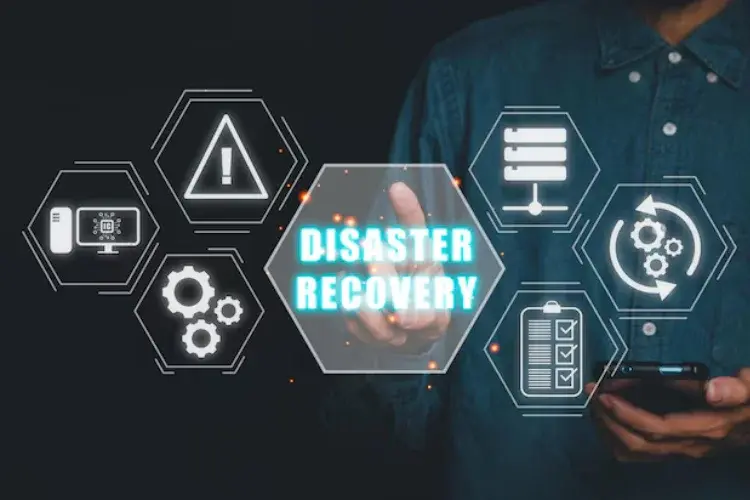The Importance of Disaster Recovery In IT
Disasters can disrupt critical systems, damage data centers, or make databases temporarily unusable. Disaster recovery planning, often overlooked, is vital for business sustainability. It ensures data backup and system recovery, helping businesses resume operations without impacting their bottom line.

This article walks you through different facets of disaster recovery (DR) as an approach to helping businesses in several other important ways. Let’s buckle up for insightful details.
Disaster Recovery (DR) Overview
Table of Contents
Disasters can hit any business without showing up on a calendar. Disaster recovery is something about a business’s technical plan for restoring its commuting workloads back on track after a disruptive event. It also emphasizes the methods for testing the applications and systems before natural disasters (fire, earthquake), power outages or cyberattacks strike. Let’s understand brief highlights of disaster recovery plans.
- Prioritizes workloads in order of importance
- Vitals of cloud computing, software architectures and IT operations
- Provides scenarios for resuming work as quickly as possible
- Ensures mitigation of interruptions in the aftermath of disaster
- An outstanding part of the organization’s continuity plan
- Allows sufficient IT recovery and data loss prevention
- Cuts down the cost of archive maintenance and comprehensive backup creation
Why is Disaster Recovery Important?
Businesses recognize disaster recovery in IT as crucial for continuity. Organizations can rarely sustain operations without processing data and restoring failures, which can result from human error, cyber-attacks, or sudden hardware issues due to external factors.
This section focuses on determining the key reasons why a disaster recovery plan (DRP) is prioritized in business organizations.
To Reduce Downtime
System downtime is a costly toll on a business’s continuity. It can cause deep financial losses due to unplanned downtime. The disaster recovery approach is substantial in preventing network disruptions and ensuring swift restoration without unwanted delays.
Ensure RTO and RPO
These two strategies are pivotal metrics for effective DR plans. Recovery time objective (RTO) defines the maximum allowable limit of application or server downtime while recovery point objective (RPO) fathoms the maximum limit of data loss a business organization is capable of penetrating.
Data Loss Prevention
From healthcare, e-commerce, and customer records to financial transactions, data remains an integral facet of every business. Losing data can exude severe consequences. According to a Forbes Report 2021, almost 40% of small and mid-sized businesses are never in a state to reopen after a natural calamity.
This highlights that disaster recovery is no longer an option but a necessity for quick data recovery, robust backup solutions, and permanent data loss prevention.
Protection from Cyber Attacks
Various data-based threats including ransomware, phishing, denial-of-service attacks and more can be readily controlled with an effective disaster recovery plan. These robust plans ensure system backups, data encryption, and multi-factor security measures reducing monetary losses and other organizational damages.
Reputational Management
Prolonged outages can harm data integrity and customer trust. Businesses need a potential DR plan to restore data and trust quickly. Through practical business continuity planning (BCP), an organization depicts its preparedness to handle uninvited disruptions effectively.
5 Key Components of Disaster Recovery Plan
Professional companies work to figure out how employees and all external stakeholders can suffer catastrophic damages as a result of any IT-related disaster. IT departments play a key role in defining which workloads can be restored from backups, which require live data flow at low capacity, and which workloads require full-scale resources for seamless working. Below are some striking components to reciprocate a variety of disaster scenarios.
Risk Assessment and Business Impact Analysis (BIA)
Let’s kickstart with the first step elucidating rigorous risk assessment of possible events that could result in software malfunction and disruption of the business operations. The other part of the same step works on evaluating the impact and estimation of financial losses. It helps organizations prioritize and protect critical systems.
Asset Identification and Recovery Methods
A practical disaster recovery plan emphasizes documenting systems, apps, data, and other critical resources for business continuity. It also works on the backup strategy for both on-site and off-site storage solutions to ensure safety against potential data losses and timely data recovery.
Cloud-based backups are more in debate due to their ability, integrity, and scalability. RPOs and RTOs play a significant role in estimating total data loss and the time required for disaster recovery.
Redundancy and Failover Systems
Redundancy involves duplicating essential networks, systems, and storage solutions to ensure the uninterrupted operation of businesses, even if one component unexpectedly fails. Failover systems complement this by automatically switching to a backup setup in the event of an unanticipated failure.
Failback, on the other hand, is a post-disaster strategy that focuses on recovering the pre-event image. It involves restoring workloads from copied systems to the primary production system. Regular testing of these strategies is crucial to ensure their effectiveness and operational readiness when needed.
Cloud-Based Disaster Recovery
Businesses are drifting their disaster recovery plan toward cloud setup due to its indisputably exceptional scalability, flexibility and affordability. Cloud-based recovery strategies enable organizations to replicate their IT infrastructure and data stored in the cloud. It makes the recovery process seamless by leveraging advanced tools and techniques including data encryption, efficient data backups and disaster recovery as a service (DRaaS).
Testing and Optimization
Creating an efficient DR plan is not enough. Disaster recovery success also depends on regular testing to measure its strength when activated. Organizations need to conduct various drills to test their reaction to different types of disasters, such as cyber-attacks, server failures or natural disasters. Another important aspect is to optimize the recovery plans to ditch slow recovery periods, unexpected downtime, and other increased IT risks.
Disaster Recovery vs. High Availability
Before you jumpstart to develop a disaster recovery plan, it is essential to understand the borderline between a high availability solution and disaster recovery. Both are the key metrics to retain system workloads preventing sky-high financial and data losses. Let’s decipher both terms to explore the distinction.
- Disaster recovery (DR) is a core ability of a business to quickly recover from disasters. These unexpected events can be in the form of dreadful cyberattacks, natural incidents, or human-triggered mishaps. The recovery plan serves as a roadmap for an organization in case of any disaster.
- High availability ensures your systems run with the least downtime so that end consumers can use your business services uninterruptedly. The high availability systems are established in a way that any sudden failure doesn’t impact its uptime.
Benefits of Disaster Recovery
In a tech-driven world, no business is immune to facing the repercussions of a disaster. Creating a proactive disaster recovery plan is a compulsion for continuity. This section brings the perks of implementing an efficient disaster recovery plan to inspire the businesses working on creating rigorous DR plans.
- Strategic planning for potential disasters can save businesses huge budgets and other sensitive resources.
- A dependable disaster recovery plan promises quick recovery of systems and restoration of data with continuity of operations.
- A proficient and successful disaster recovery plan ensures the maintenance of high service quality with sustainable customer retention.
- The right minds in place can better execute the disaster recovery plan. When specific responsibilities are assigned before time, productivity is guaranteed. Indirectly, it improves employee productivity.
- It provides an in-depth understanding of scalability. Cloud-based data storage and backups can better streamline IT processes. Thus, cloud-based disaster recovery solutions are more scalable and profitable.
Disaster recovery in IT is beyond a technical concern. The prevalent reliance on digital technologies and the growing cyber threats spectrum demand robust disaster recovery plan insurance. It is more dependable, quick and financially stable. To grow a business beyond surviving a crisis, it is imperative to lean on professional and advanced IT solutions.
Facing IT Challenges in Chicago?
Schedule a consultation with our expert team to get the help you need!
Related Articles

Colocation: A Strategic Lever in Project Management

Leading Benefits of IoT Integration Services


